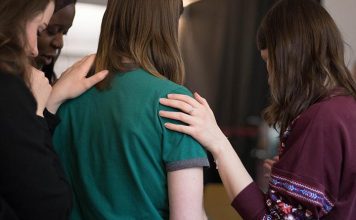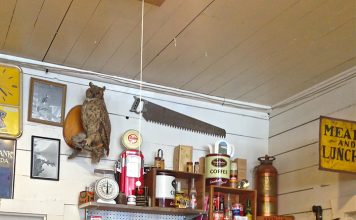 |
|
| Issue #131 • September/October, 2011 |
So, I’m sitting here in a hotel writing this, less than three hours after getting off the witness stand in a manslaughter case. The defendant was a 5’3″, 130-pound female who was being stalked by her sometimes-abusive estranged husband. It was a “backwoods home” kind of incident: the ex accosted her, with a male relative along (for moral support presumably), when she was trapped on a narrow dirt path on her dad’s rural shooting range. There was no escape: her car was blocked in by his, and he had deflated one of her tires. Things escalated; he punched her, threw her to the ground, and kicked her. She took the beating in a fetal position, curled up to keep him from getting the gun that was tucked center-front inside her waistband. He left her on the ground and strode triumphantly back to his car, snarling “stupid bitch!” over his shoulder as he went. As he reached the car where she feared he had a weapon, he spun to face her, shouted a challenge, and appeared to be about to lunge at her again. At a range both prosecution and defense stipulated to be fifteen and a half feet, she fired from the ground. A .38 Special bullet cut his spinal cord, and he fell. The assault was over.
One reason I believe she was able to get the hit that probably saved her from being killed or crippled was that she was given that revolver by a father who was wise in the ways of firearms, and understood that the gun has to fit the shooter. It was a Colt SF-VI, an uncommon late variation of the D-frame revolver Colt introduced in 1907 as the Police Positive, and brought out with a short barrel like the SF-VI’s in 1926 as the Detective Special. It’s one of those very rare handguns that seems to fit small female hands and large male hands equally well. As I sit here waiting for the verdict, I’m reminded of a basic fact:
For equipment to work, it has to fit the user.
If you put a five-foot-tall woman behind the wheel of a truck or automobile whose seat has been adjusted for a six-foot-six male driver, she’s not going to be able to drive that vehicle as safely or as well as she could if the seat was properly adjusted. The reach to the steering wheel won’t be right for her shorter arms, nor the reach to the pedals for her shorter legs. It might even get to where she’s not safe for herself or others running that poorly-fitting machine.
It’s exactly the same with guns. When I learned that editor Annie Tuttle a willowy, petite female herself wanted an article on this topic, the same week I was in court for the above-mentioned case, supporting information was more readily at hand than usual.
|
Basic physical differences
In Volume 66, Number Three of the European Journal of Applied Physiology and Occupational Therapy, we find an article titled “Gender Differences in Strength and Muscle Fiber Characteristics” by A.E.J. Miller, J.D. MacDougall, M.A. Tarnopolsky, and D.G. Sale. They write of their research on the title topic, “The women were approximately 52% and 66% as strong as the men in the upper and lower body respectively. The men were also stronger relative to lean body mass.”
As a rule of thumb, it seems that few experts predict a woman to have more than two-thirds of a man’s strength, even if the woman in question is the same height and weight as the man. Where does upper body strength come into it? If you’re firing a rifle or shotgun from what we call “offhand,” the standing position, one arm (usually the weaker, non-dominant arm) is out in front, supporting the weight of the gun and trying to hold it steady on the target.
Accordingly, a rifle or shotgun that’s lighter in the front makes sense for someone whose long suit isn’t upper body strength.
There’s also the element of stock length. Col. Charles Askins, Jr., the legendary 20th century gun expert, was sent to Vietnam to train our allies there in riflery back in the 1950s. He found a population of soldiers whose height, on average, was about that of the average American female. The US Army had equipped them with surplus WWII Garand rifles, long guns that weighed nearly 10 pounds loaded. Col. Askins experimented with shortening the stocks at the butt and found that it helped, but the guns were still muzzle-heavy and hard for them to hold steady on target from an offhand position. When I discussed it with him back in the mid-’70s, he told me that the little M1 carbine a much shorter gun, weighing only six or so pounds was much easier for them to manage. The .30 carbine round was anemic compared to the powerful .30-06 cartridge fired by the Garand, but the Colonel wisely reckoned that a hit from the carbine would do a lot more damage to the enemy than a miss from the more powerful, larger rifle.
|
Shortening the butt
In days of old, the traditional way of fitting a kid to a rifle or shotgun was to carefully saw off the back end of the stock, perhaps in slices like sliced bread. As the youngster “grew into the gun,” lengths of the stock would be glued back in place, like adding bread slices, until it was eventually back to full length. Spend enough time cruising gun shops and gun shows or just checking the gun cabinets in some rural families’ homes and you’ll see shotguns and rifles which exhibit lines on the stocks where those segments were glued back on. You can almost count them as growth rings, like the rings inside the cross-section of a tree trunk. Often, for esthetics, a slip-on recoil pad like the Pachmayr would be applied, covering the glue lines and softening kick a little bit. (Those slip-on recoil pads can be handy things, sort of like rubber galoshes for guns. Like galoshes, they look ugly and sometimes fit sloppily, but also like galoshes they more or less get the job done.)
By the mid-20th century it came into vogue for gun manufacturers to offer rifles and shotguns with “youth stocks,” pre-shortened to fit smaller folks. The theory was, as the kid grows up, the parent simply removes the metal-ware, the “barreled action,” and fits it to an adult-size stock.
It turned out that “youth stocks” tended to fit petite to average-size females remarkably well. That is still the case. And of course, since the adult female won’t be getting any taller and her arms won’t be getting any longer, the need to buy a longer stock in the future is eliminated.
|
Adjustable stocks
1994-2004 was the decade of the late and unlamented Clinton Assault Weapons Ban, which among other things forbade adjustable length stocks for rifles like the ubiquitous AR15. The multiple-position collapsing stock allows it to instantly adjust for arm length. It is a simple and remarkably effective solution to the stock length problem. The most common caliber for the AR15 rifle is .223 Remington/5.56mm NATO, which most of us consider a bit light for a deer rifle, but the AR platform is available in 6.8mm, a cartridge more suitable for deer-size game. Ergonomic in most other respects as well, an adjustable stock is the key for fitting such rifles to the physically smaller shooter. The telescoping stock is available for some other semiautomatic rifles as well, including one of our most popular .22s, the Ruger 10/22.
Telescoping stocks are also available for slide-action and semiautomatic shotguns. They’re a functional alternative to the youth stock, if non-traditional looks don’t get in the way of the given shooter’s enjoyment of hunting and shooting experiences.
The dimension we’re looking at is called “pull.” On the gun, it is measured from the butt to the trigger. The quick “rule of thumb” test in the gun shop is to confirm that the rifle or shotgun is empty, bend your shooting arm 90 degrees, and place the butt in the inside crook of the elbow. If the trigger finger comfortably reaches the trigger, its fit for that shooter is generally considered “good to go.”
The Winchester Model 70 Featherweight bolt action hunting rifle has just been reintroduced in a short stock format. The manufacturers’ PR folks write, “With smaller-framed shooters and those who like a lightweight compact rifle in mind, Winchester Repeating Arms has introduced the Model 70 Featherweight Compact. The new rifle features a 20-inch barrel, a 13-inch length of pull, an overall length of 39½ inches and weighs just 6½ pounds. The Model 70 Compact is the perfect rifle for ladies, young shooters, and those looking for a light-weight mountain rifle.”
For a rifle or shotgun, that thirteen-inch pull measurement seems just about right for the smaller-statured shooter. The Model 70 can be had in such popular hunting calibers as .243 and .308. Most of the other makers of bolt action rifles produce similar-size guns in a similar array of calibers. If you prefer a lever action, Marlin offers a shorter-stocked version of their classic .30-30. Remington and other makers have “youth-stocked” autoloading and slide-action shotguns.
|
Handguns
While I was writing this article, the jury brought in a quick, clean verdict: Not Guilty on all counts. As noted earlier, that life-saving little Colt .38 fit the petite shooter’s hand well.
Over the years, we’ve found some other handguns that work very well in smaller hands. One is a classic 1935 design, the 9mm Browning Hi-Power, now also available in caliber .40 S&W. Another, counterintuitively, is a classic “big man’s gun,” the 1911 pistol, a/k/a the Colt .45 automatic.
After WWI, the US Army Ordnance board conducted an assessment of small arms used in the conflict. Many doughboys complained that the trigger on the 1911 .45 pistol was too long. In the 1911A1 update of that handgun in the 1920s, the trigger was shortened considerably and the frame was niched out at the back of the trigger guard area, so the shooter “could get more finger on the trigger.” This turned out to be an ideal trigger reach for short fingers. 1911s are also available in calibers that kick more softly than .45, such as .38 Super and 9mm.
As “pull” in terms of stock length is the key to the shooter finding a rifle or shotgun that fits her, “trigger reach” is the most important dimension for fitting the pistol or revolver to the hand. Holding the unloaded handgun with its barrel straight in line with the long bones of the forearm, the index finger wants to be able to comfortably reach the trigger with enough leverage to pull it straight back without deviating the muzzle off target.
That finger placement is in part dependent on the weight and length of the trigger pull. With a semiautomatic target pistol that might have a “light trigger” of less than four pounds pull weight, the tip or the pad of the finger may be sufficient. (The “pad” of the finger is generally described as where you would find the whorl of the fingerprint.) This is also a suitable finger placement on most rifle and shotgun triggers. However, if the shooter has something like a double action revolver whose trigger pull is long and relatively heavy, she’ll want to be contacting the trigger at the crease of the index finger’s distal joint. This will give the finger more leverage with which to bring that trigger straight to the rear while still holding the muzzle on target.
|
Adjustable grip pistols
In addition to the older handgun designs mentioned above, it is definitely wise to check out the modern generation of polymer-framed semiautomatic pistols with interchangeable “straps” on the back of the grip-frame. The concept dates back to Walther of Germany in the early 1990s, and in addition to that company’s products can be found on several more: the Smith & Wesson Military & Police auto pistol line, some of the Heckler and Koch pistols, the XD(m) imported to the US from Croatia by Springfield Armory, and the recently introduced Gen4 Glock series. The interchangeable hard backstraps allow the guns to be fitted to a wide variety of hands. The adjustment potential greatly improves the shooter’s ability to achieve a trigger reach that fits her hand.
My friend Melissa Oman is in charge of firearms training for the Florida Highway Patrol. Not too long ago, her agency became the first department in the country to adopt the Gen4 Glock 37, a service pistol that holds eleven rounds of .45 GAP. The GAP (Glock Auto Pistol) round is a shortened version of the great old .45 ACP (Automatic Colt Pistol) cartridge which duplicates the ballistics of a full power, standard pressure ACP round. Melissa formed a selection committee that included veteran troopers and district post firearms instructors from all round the state, to evaluate a number of different firearms when it came time to select a new pistol.
The Gen4 Glock was the majority choice because, in part, of its interchangeable backstrap feature. It was imperative that the gun fit the hands of the many petite female troopers on the force. The committee felt that the Gen4 Glock achieved this better than anything else they tested.
Melissa tells me that since the adoption, virtually all the smaller-handed female troopers issued the new gun have gone with the shortest trigger reach its optional fit offers. Interestingly, a significant majority of larger-handed troopers of both genders have made the same choice.
|
The pool firearm
A “pool” gun is one that will be used by multiple people. The rifle and shotgun my department has in every patrol vehicle may on a given day have to be used by a day shift officer, an evening shift patrolman, and a midnight shift cop: therefore, each is a “pool weapon.”
If a farmhouse has only one rifle or shotgun available, that’s also a “pool gun” situation. When the fox is in the henhouse or when a home invader is kicking in the door, that gun may have to be used by six-foot Dad, five-foot Mom, or a responsible adolescent well-trained by parents in emergency management. The gun will have to fit them all adequately.
My advice for a pool firearm is this: SET IT UP TO FIT THE SMALLEST PERSON AUTHORIZED TO USE IT! Yes, the all caps and the exclamation point DO mean I’m shouting, because this point is deserving of special emphasis.
A stock that’s too long for the shooter is absolutely destructive to their ability to effectively use the rifle or shotgun. Many of us have seen (or been) the little kid who fires Daddy’s 12-gauge and gets knocked flat on his or her butt. The reason is that to hold the long-stocked gun up, the shooter has to rock her shoulders back. This takes her off-balance. I’ve seen physically strong but short-statured women trying to rapidly fire “man-size” 12-gauges with their front foot literally off the ground after the second or third shot. I’ve seen them staggered backward by the recoil. The reason is that the too-long stock forces them off balance.
A SHORTER than optimal length stock, by contrast, presents a much smaller problem to the larger shooter. One simply tucks into the gun. (Taking the shotgun down to 20 gauge, by the way, affords softer recoil, and still is amply powerful for many shotgun tasks.)
With handguns, a too-long trigger reach is destructive to accuracy because the shooter has to make one of two unsatisfactory accommodations. Either the finger isn’t on the trigger enough, which will tend to cause the finger to “push the shot” to the left for a right-handed shooter (vice versa for a southpaw), or the hand has to twist around to where recoil is channeled painfully into the thumb instead of the web of the hand, which can severely impair recovery from recoil between shots.
However, when the gun with shorter trigger reach is in a larger hand, it’s no big trick for the shooter to simply flex the median joint of the trigger finger outward a little bit, to make the trigger pull manageable. Thus, with handgun as well as long gun, the larger shooter adapts to the shorter person’s firearm more easily and effectively than the smaller person can adapt to a firearm fitted for a larger shooter.
Bottom line
Fit. It’s a critical factor in the interface between us humans and the machines and tools we use. The firearm is a tool. Fit it right to the user, and it will serve you well.





















No mention of the Sig Sauer P320? The Small, Medium & Large Grip Modules in different lengths make this weapon ideal for a wide range of hand sizes. My Wife has baby hands and loves the Small/Carry-size Grip Module.
The old check the fit by sticking it the crooked elbow trick sometimes works and sometimes doesn’t. While it accounts, mostly, for arm and hand/finger length, it does nothing to account for chest/shoulder size/bulk, and especially doesn’t address neck length. Further, it doesn’t address strength.
Great article Mas !! As you well know thanks to you and Rick the grip and trigger pull on my Glock 19 was customized to fit my small hands and for that I will be forever grateful. In the past, more woman I know and taught shied away from a lot of different more powerful handguns and shotguns because the weapons were just too difficult to control with “tiny hands” and stature of the female body. So glad to see the industry has recognized this and are catering to woman shooters. Again, thanks for a terrific article. It will be widely shared.
Doc Trinidad,
She was found not guilty.
So how did the case turn out?
Good article. Length of pull explained well.
Thank you so much for this article. I have been trying to explain this to all the men that are always frustrated with me because I couldn’t get the results they expect when trying to teach me to shoot with their guns. I keep saying it feels like the gun is to big for my smaller frame.